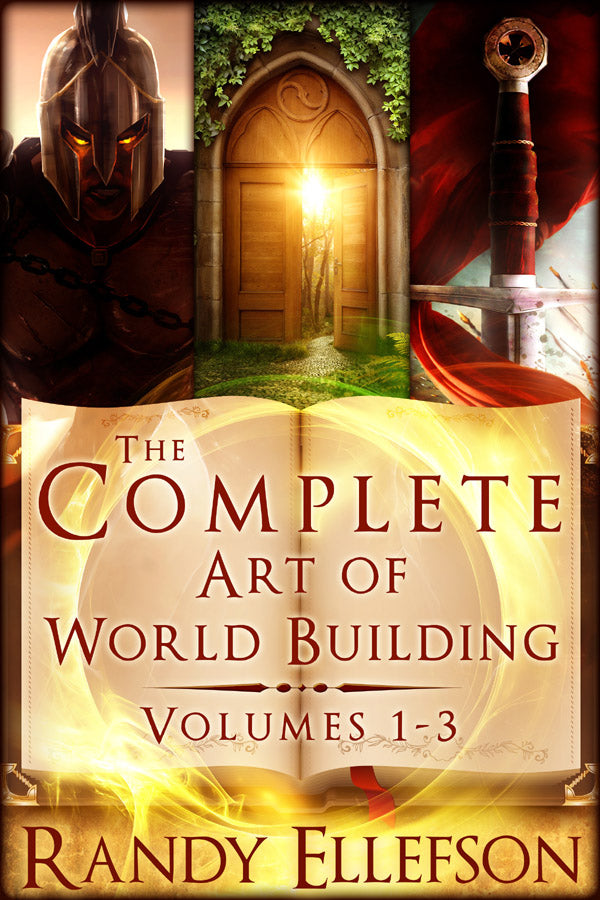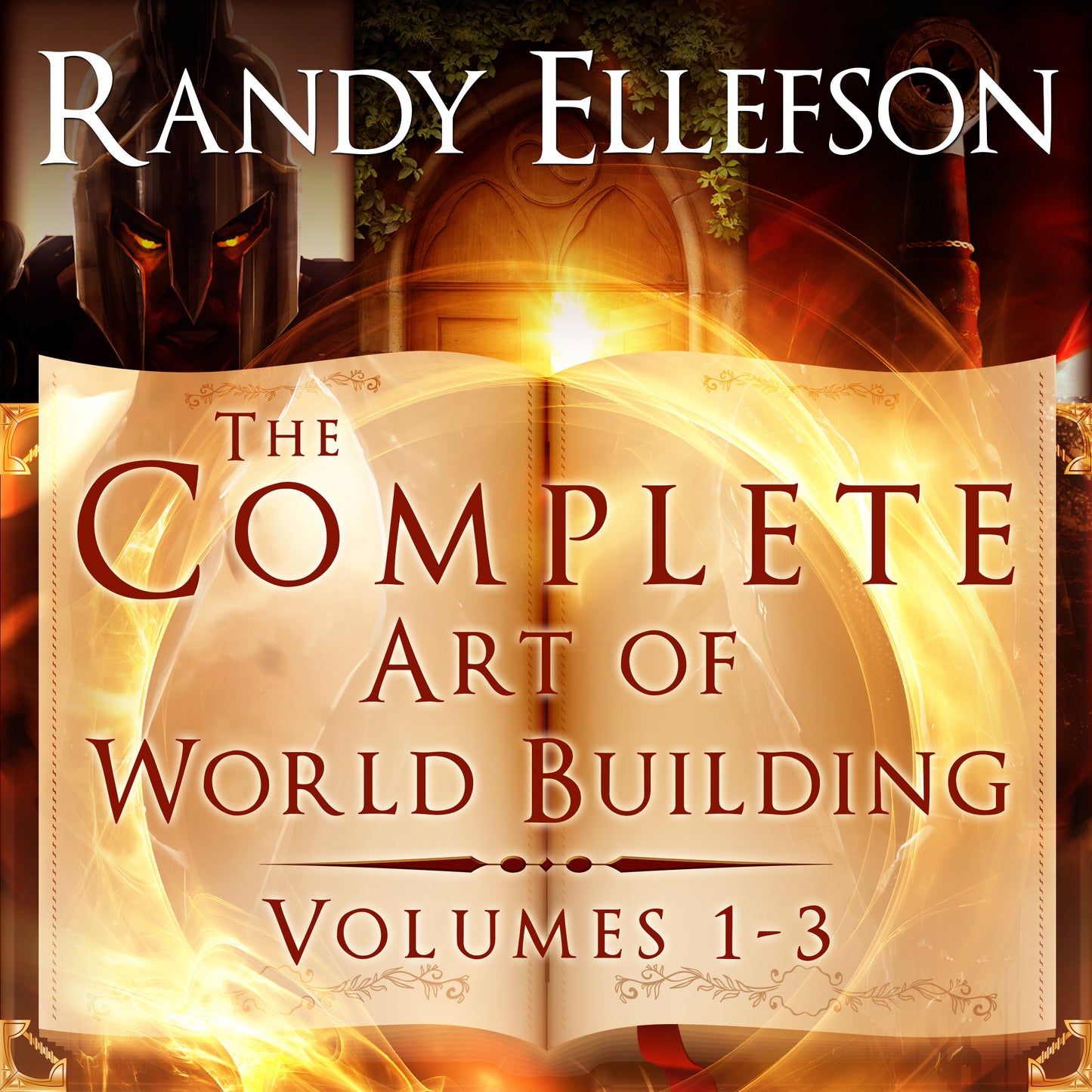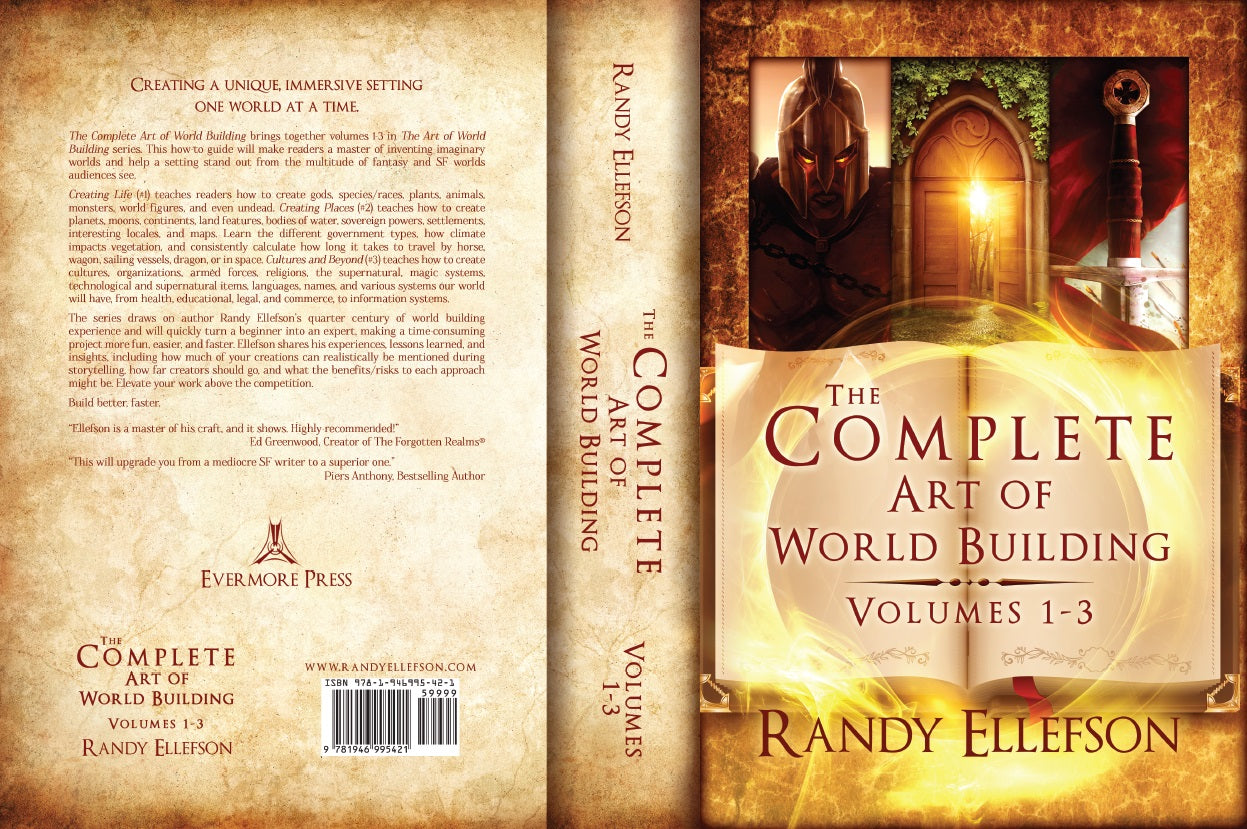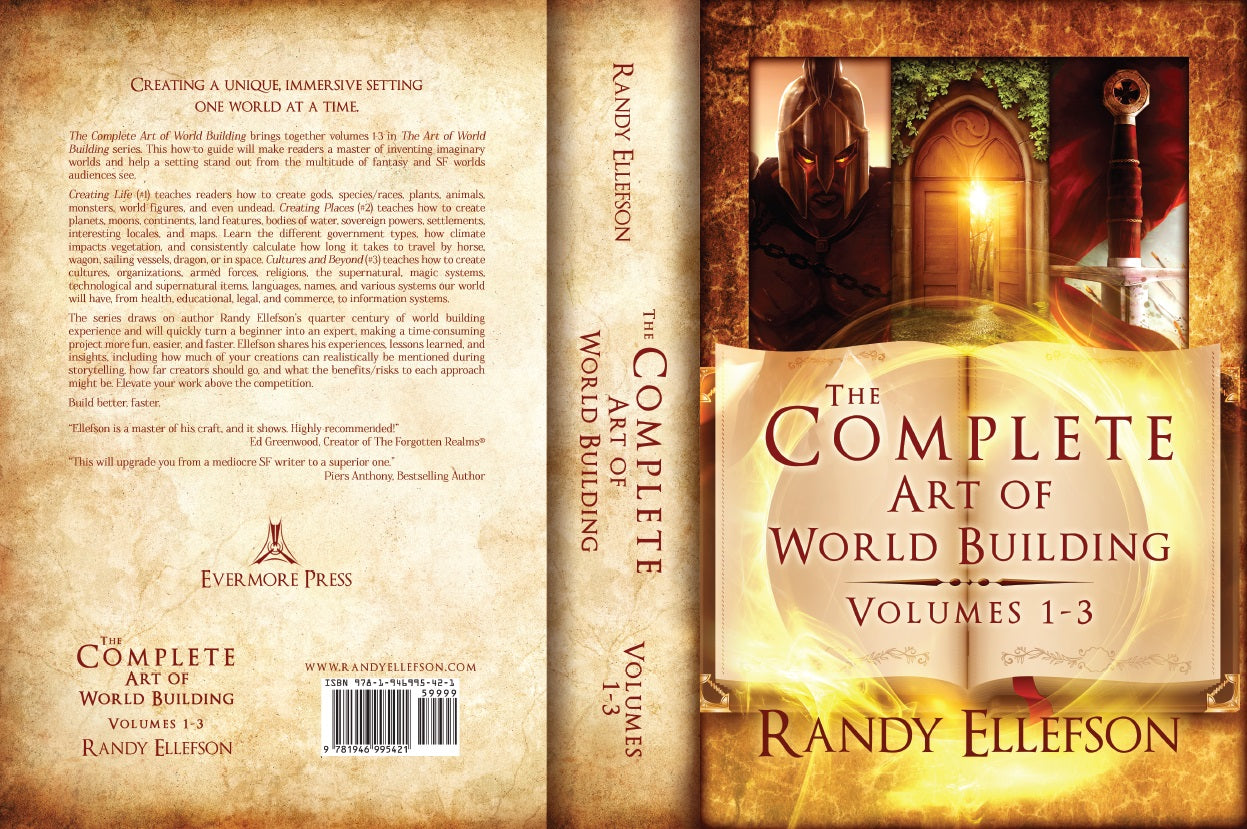The Complete Art of World Building
The Complete Art of World Building
4.6 Stars, 72 Amazon Ratings (as of 1/2024)
Creating a unique, immersive setting one world at a time
A guide for authors, gamers, and hobbyists
The Complete Art of World Building brings together volumes 1-3 in The Art of World Building series. This how-to guide will make readers a master of inventing imaginary worlds and help a setting stand out from the multitude of fantasy and SF worlds audiences see.
Creating Life (#1) teaches readers how to create gods, species/races, plants, animals, monsters, world figures, and even undead. Creating Places (#2) teaches how to create planets, moons, continents, land features, bodies of water, sovereign powers, settlements, interesting locales, and maps. Learn the different government types, how climate impacts vegetation, and consistently calculate how long it takes to travel by horse, wagon, sailing vessels, dragon, or in space. Cultures and Beyond (#3) teaches how to create cultures, organizations, armed forces, religions, the supernatural, magic systems, technological and supernatural items, languages, names, and various systems our world will have, from health, educational, legal, and commerce, to information systems.
The series draws on author Randy Ellefson’s quarter century of world building experience and will quickly turn a beginner into an expert, making a time-consuming project more fun, easier, and faster. Ellefson shares his experiences, lessons learned, and insights, including how much of your creations can realistically be mentioned during storytelling, how far creators should go, and what the benefits/risks to each approach might be. Elevate your work above the competition.
Build better, faster.
Couldn't load pickup availability
Share



Product Details
Editorial Reviews
Endorsement from Ed Greenwood, inventor of The Forgotten Realms and dozens of imaginary worlds
"Worldbuilding—creating a fictional setting—is THE biggest job of a storyteller. It can be done badly or minimally, but doing so risks robbing a tale of richness and impact, by leaving the audience uncaring or making “the stakes” less clear or dramatic.
So, after “once upon a time,” where to begin this devastatingly big job? With CREATING LIFE by Randy Ellefson, even the first volume of which is THOROUGH. This book raises ALL the points, and asks all the questions. Not just recommended: essential!"
"With CREATING PLACES, Randy Ellefson has penned a sequel to his CREATING LIFE that walks story creators through worldbuilding along an entertaining road that runs everywhere, making sure nothing is missed. Plentiful examples are provided, and a veteran worldbuilder can find just as much fun and comprehensive reminders in these pages as a novice. Some books are nice to have, and a rare few are “must haves.” Like Ellefson’s preceding book, CREATING PLACES is one of that rare breed: an essential reference work. Unlike most references, this one is fun to read. Not to mention a goad and spark for the imagination!"
In Cultures and Beyond, Randy Ellefson continues his masterful overview of worldbuilding, carefully and coherently dealing with every last detail of creating and tending imaginary settings that his previous worldbuilding books, Creating Life and Creating Places, haven’t covered. All three are essential reference works for storytellers working in all fields; more than any other approach to these
topics, Cultures and Beyond and its prequels ensure that nothing is overlooked or missed. Ellefson is a master of this craft, and it shows. Highly recommended!
Endorsement from NY TImes Bestselling Author Piers Anthony
"I read Creating Life (The Art of World Building, #1),
by Randy Ellefson...It is exhaustive, well written, and knowledgeable...I, as a successful science fiction and fantasy writer, have generated many worlds, so
this material is familiar, but it would have been easier and probably better had I had a reference like this. It is realistic, recognizing that the average
writer may not have the patience to work out all the details before getting into the action..."
"Creating Places also has advice along the way on writing that I'm sure novice writers and perhaps
some established ones too can profit from. I recommend this book as a basic reference; at worst it is a review of necessary concepts, and at best it will upgrade you from a mediocre speculative fiction writer to a superior one."
I read Cultures and Beyond, The Art of World Building 3, by Randy Ellefson. I reviewed the prior two volumes, Creating Life and Creating Places, when they were published. Each volume is a comprehensive discussion of its subject, useful for new writers and surely for established ones too. I have been writing and selling novels for more than half a century, and I have been learning things here. I recommend all three for background reading for those who are serious about the worlds they create. The present volume is amazingly informative about the several aspects of culture, covering armed forces, religions, supernatural aspects, languages, and everything in between. It even lists all the American military ranks. Take a
supposedly minor aspect, creating names. I have a small collection of books of names, which I use for my characters, trying not to duplicate myself too often, but I see I am an amateur in this respect. Naming names can be a science! Every section of this volume is similarly detailed. I am not sure
whether reading it would cure the dread Writer's Block for those who suffer it, but if a writer runs out of inspiration, reading this book well might restore
it. Certainly it should be on the shelf, as it were, ready to check when uncertainty threatens.
Read a Sample
Table of Contents
Creating Life TOC
Introduction
- Introduction
- Where to Start
- About Me
- Free Book
- Disclaimers
- The Chapters
- Templates and Newsletter
Chapter 1 - Why Build a World?
- Why Build a World?
- Using Analogues
- How Many Worlds?
- A Caveat
- A Question of Depth
- The Problem of Exposition
- The Value of Influences
Chapter 2 - Creating Gods
- Creating Gods
- In Science Fiction
- In Fantasy
- Pantheons
- Mythology
- Characteristics
- Behavior
- Where to Start
Chapter 3 - Creating a Species
- Creating a Species
- Species or Race?
- Should You Create Your Own Species?
- Habitat
- Disposition
- Appearance
- Gods
- Characteristics
- Worldview
- Relationships
- Supernatural
- Technology
- Combat
- The Value of Influences
- Where to Start
Chapter 4 - Creating World Figures
- Types
- Fame
- Dead or Alive
- Possessions
- Steeds and Ships
- Relationships
- History
- Where to Start
Chapter 5 - Creating Monsters
- Creating Monsters
- Defining Monster
- Origins
- Habitat
- Motivation
- Characteristics
- Where to Start
Chapter 6 - Creating Plants and Animals
- Should You Create Plants and Animals?
- Plants
- Animals
- Purpose
- Where to Start
Chapter 7 - Creating Undead
- Creating Undead
- Should You Create Undead?
- The Mind
- Classification
- Numbers
- Prerequisites and Prevention
- Time Dead
- Origins
- Goals
- Appearance
- Traits
- Death
- Where to Start
Appendices - The Templates
- God
- Species
- World Figures
- Monster
- Plants
- Animals
- Undead
Creating Places TOC
Introduction
- Introduction
- Where to Start
- About Me
- The Chapters
Chapter 1 - Case Studies
- Two Straits and a Sea of Enemies
- Stopping an Empire
- Mountains and Murder
Chapter 2 - Creating a Planet
- Creating a Planet
- The Sun
- Moon(s)
- Other Planets
- Stars
- Asteroids and Comets
- A Planet
Chapter 3 - Creating a Continent
- Creating a Continent
- Multiple Continents
- Which Hemisphere
- Plate Tectonics
- Seas vs. Oceans
- Bays and More
- Islands
- Where to Start
Chapter 4 - Creating Land Features
- Creating Land Features
- Mountain Ranges
- Water
- Forests
- Prairies/Grasslands
- Wetlands
- Deserts
- Settlements
- Where to Start
Chapter 5 - Creating a Sovereign Power
- Sovereignty
- Roles
- Branches of Government
- Parliamentary Systems
- Government Types
- How Many Powers to Invent
- Invent for Today
- Population Count and Type
- World View
- Location
- Relationships
- Ways to Identify a Power
- Reputation
- Where to Start
Chapter 6 - Creating a Settlement
- Creating a Settlement
- Location
- The Population
- Zonings
- Settlements Types
- Defenses
- History
- How It Is Known
- How Many Places to Create
- Where to Start
Chapter 7 - Travel over Land
- Travel over Land
- Mode of Travel
- Obstacles
- Calculation Preparation
- Calculations
- The Template
Chapter 8 - Travel by Water
- Travel By Sea
- Some Terms
- Ship Rates
- Ship Types
- Privateer
- Ship Speeds
- Weapons
- Personnel
- Where to Start
Chapter 9 - Travel in Space
- Travel in Space
- The Realities of Space
- Propulsion
- Distance
- Ship Structure
- Where to Start
Chapter 10 - Creating Time and History
- Creating Time and History
- Sample Entries
- Creation Myths
- Time
- Uses for History
- Event Categories
- Where to Start
Chapter 11 - Creating Places of Interest
- Creating Places of Interest
- Ordinary Ones
- Extraordinary Places
- Phenomena
- Ruins
- Shipwrecks
- Event Sites
- Meteors
- Where to Start
Chapter 12 - Drawing Maps
- Drawing Maps
- Continental Maps
- Drawing the World
- Settlement Maps
- Dungeon/Ship Maps
- Map Generation Software
Appendices - Templates
- Sovereign Powers Template
- Settlement Template
Cultures and Beyond TOC
Introduction
- Introduction
- Where to Start
- About Me
- Free Book
- Disclaimers
- The Chapters
- Templates and Newsletter
Cultures
- What is Culture?
- Culture Depictions
- Creating Culture
- Where to Start
Organizations
- Group Types
- Common Traits
- History
- In and Out
- Where to Start
Armed Forces
- Locations
- Their Weapons
- Their Defenses
- The Road to Becoming One
- Identifiers
- Those Who Serve
- History
- World View
- Where to Start
Religions
- Overview
- History
- Beliefs
- Names
- Followers
- Worship
- Locations
- Identifies
- Clergy
- World View
- Combat
- Afterlife
- Where to Start
The Supernatural
- Supernatural Energy
- Magic Paths
- Alternate Realities
- Supernatural Beings
- Prevalence
- The Impact
- Where to Start
Systems of Magic
- Principle of Good Magic Systems
- Do We Need a Magic System?
- Types of Magic
- Magic Prevalence
- Where Does Magic Come From?
- Social Aspects
- What's in a Name?
- Are Spells Needed?
- The Life of Wizards
- Creating Limits
- How to Invent Spells
- Where to Start
Items
- All Items
- Regular Items
- Magic Items
- Technological Items
- Where to Start
Languages
- Should We Create One?
- The Medium
- Our Options
- How to Hire Someone
- Where to Start
Names
- People Names
- Place Names
- Uniqueness
- Leveraging Existing Names
- General Tips
- Techniques for Inventing Names
- Name Generators
- Where to Start
Other Systems
- Education Systems
- Health Systems
- Legal Systems
- Commerce
- Information Systems
Conclusion
- Goals
- Abide By Rules
- Tying It All Together
- Approaches
- Top Down
- Bottom Up
- Random
- What to Do?
- File Storage
- Get Organized
- World Building Coalitions
- Last Words
Templates
- Culture
- Organizations
- Armed Forces
- Religions
- Supernatural Energy
- Supernatural
- Magic Systems
- Spells
- Legal
- Monetary
- Education
I bought the set fot my ilfest Grandaughter, She thinks they are fantastic and has already been using what shes learned to improve her story telling.



